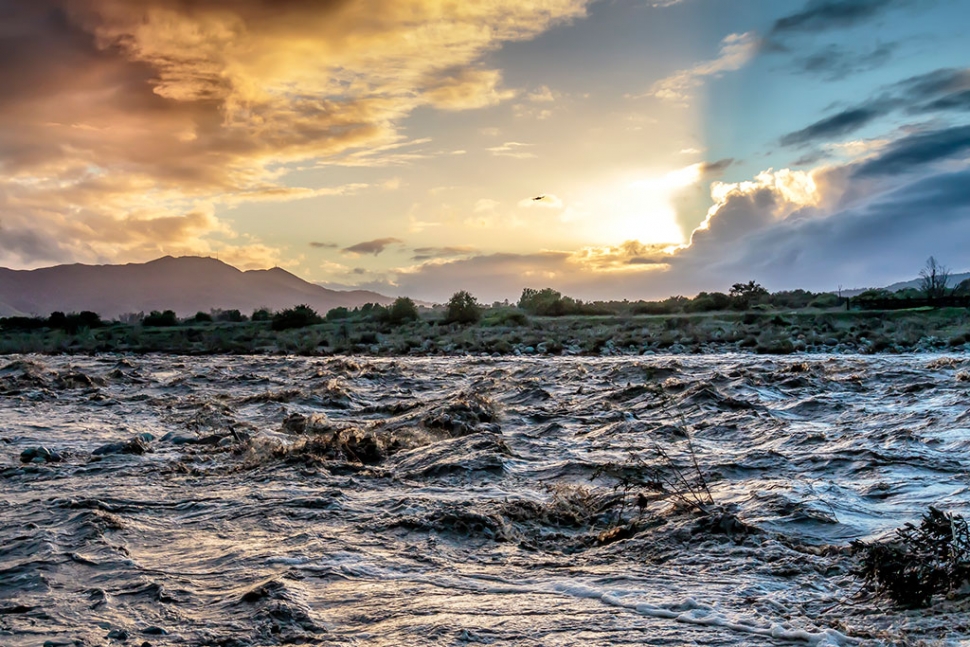|
Focus on Photography
 Photo of the Week: "Roaring Sespe Creek at sunset" by Bob Crum. Photo data: Canon 7DMKII camera, manual mode, Tamron 16-300mm lens @28mm, exposure ISO 800, aperture f/10, shutter speed 1/500 of a second. By Bob Crum — Wednesday, February 6th, 2019
Location, location, location!
 Bob Crum Alas, wet, juicy rain from on high. Except for a leaky umbrella, I'm not complaining. Nosireebob! The much-needed water is greatly appreciated. However, the dainty Sespe Creek mermaids don't enjoy frolicking in a muddy torrent. A text told me they left for calmer, and clearer, Ventura Harbor waters. But I digress. Sespe Creek, with headwaters at Potrero Seco at 5,280 feet in the eastern Sierra Madre Mountain, is approximately 61 miles long. From beginning to end, more than thirty tributary streams of the Sierra Madre and Topatopa Mountains feed the unrestrained free-flowing Sespe. The sprawling territory of the watershed encompasses 260 square miles. If my math is correct, that's 166,499.294 acres. That's a large area for rain to dump on and run down to the creek. Since hills are covered with soil, the runoff is, well, you know, muddy. Streams, creeks and rivers - each with unique and fascinating personalities - are interesting bodies of water as well as exciting photo ops. From any vantage point, observe any flowing body of water at any time of the year and you will see unique characteristics. Two weeks later, from the same place, you'll often find that it's different. A month ago there wasn't a drop of water flowing in Sespe Creek. It's now a raging torrent. During a break in the weather last Saturday afternoon, the Sespe beckoned. I first made several photos from the bank north of the railroad bridge. As dusk drew nigh, time for plan B: Sunset photo on the bank of the roaring Sespe. As you might guess, good photos don't just happen. They require four things: planning, composition, appropriate camera programming and some post-processing. Oh, and one other thing: Patience. Planning and composition meant I needed to skedaddle over to a location south of Old Telegraph road. Now on the eastern bank (location!), I was greeted with an exposure dilemma. The sun was very bright. If I set exposure settings for the brightness, the muddy water was too dark. Expose for the dark muddy water and the sky was blown out. Bountiful clouds off on the horizon. Hmmm. I waited. And waited. Patience, remember? As hoped, the sun began dipping behind some clouds. Hallelujah! Now, with the right aperture and shutter speed, I could balance the light of the sky and on the water. Bingo! Whoa! Not one and done! It's never a good idea to merely make one photo and skadoo thinking that you've got the best possible photo! Varying the composition can produce entirely different images. Equally important, various combinations of aperture and shutter speed produce different exposures, one of which will ultimately be the best. As the sun steadily descended, and ISO on auto, I continued to shoot varying the aperture and shutter speed. The tally? A scant 38 photos. I hope that I was legally allowed to have so much fun! In case you're wondering, I did consider shooting the scene in HDR (high dynamic range) mode, bracketing the exposure in 5 successive frames. But when the sun ducked behind the clouds, I was confident I could achieve a relatively balanced and correct exposure without HDR. HDR processing sometimes produces artifacts that degrade the image. Later at home, I sorted the photos selecting one to post process. I further tweaked the exposure with my computer darkroom using Adobe Lightroom (LR). The graduated filter in LR is an awesome aid for fine-tuning exposure balance. I polished the image with NIK plugins in Photoshop Elements. Bingo! Photo of the week! Happy photoing! Send comments, questions or suggestions to: focusonphotography@earthlink.net |
